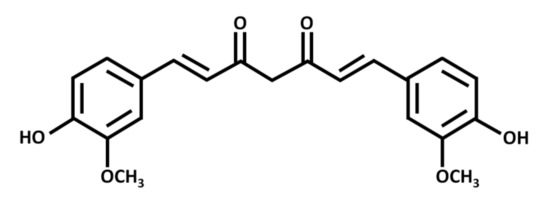Curcumin, a natural polyphenolic compound derived from the South Asian turmeric plant (Curcuma longa), has well-characterized antioxidant, anti-inflammatory, anti-protein-aggregate, and anticancer properties.
- curcumin
- curcuminoid
- polyphenol
- natural compound
- oncology
Curcumin ((1E,6E)-1,7-bis(4-hydroxy-3-methoxyphenyl)hepta-1,6-diene-3,5-dione) is derived from the rhizome of the turmeric plant (Curcuma longa). Turmeric is native to South Asia (e.g., India, China, and Indonesia) and is cultivated for its traditional medicinal properties [42].
Curcumin exists as a yellow-orange solid, with a molecular weight of 368 g/mol and a melting point of 183 °C. Chemically, it is a polyphenolic compound with two aromatic rings, each with one hydroxy and one methoxy substituent (Figure 1). A seven-carbon chain with two α-β unsaturated carbonyl groups (which are subject to tautomerization) links the rings [43].

Figure 1. Chemical structure of curcumin, a polyphenolic chemical constituent of turmeric with antioxidant, anti-inflammatory, and anticancer effects. Curcumin is a beta-diketone compound containing two substituted aromatic rings linked by a seven-carbon chain. Each aromatic ring has one hydroxy and one methoxy group.
Commercially available curcumin contains three primary components, namely diferuloylmethane (the most abundant and active component of turmeric, at 82%) and its derivatives demethoxycurcumin (15%) and bisdemethoxycurcumin (3%); these are collectively referred to as “curcuminoids” [44,45]. Curcuminoids have the potential to treat various diseases through the modulation of molecular signaling targets, including transcription factors (e.g., NF-κB, AP-1, ß-catenin, and peroxisome proliferator-activated receptor), enzymes (e.g., COX-2, 5-LOX, and iNOS), and pro-inflammatory cytokines (e.g., TNF-α, IL-1, and IL-6) [44,46,47,48,49,50,51].
The biological and physiological properties of curcumin have been extensively examined and reviewed in the context of neurodegenerative and inflammatory diseases, such as Alzheimer’s disease and dementia. Curcumin exhibits notable antioxidant activities through iron chelation, inhibition of lipid peroxidation, and scavenging of reactive oxygen species (ROS) [52]. The compound also has anti-inflammatory properties in acute and chronic inflammation [53]. Beyond these functions, curcumin is widely examined as an anticancer agent. Orally administered curcumin—alone and in combination with conventional chemotherapeutics—has been clinically trialed in pancreatic, breast, and prostate cancer patients [54,55,56,57]. Curcumin also demonstrates oncologic effects by itself on murine glioblastoma xenografts and in combination with the chemotherapeutic 5-fluorouracil on colorectal cancer cells [49,58,59,60].
Although curcumin has many positive effects on health, it is sometimes criticized for its low bioavailability—a result of its low absorption and rapid metabolism by the body. However, its bioavailability can be enhanced through combination with adjuvants. Indeed, piperine, a component of black pepper, is suitable for this purpose [61,62,63]. Notably, while curcumin’s anticancer properties are frequently reported, its membrane transport mechanisms remain mostly uncharacterized. Molecular dynamics simulations and solid-state nuclear magnetic resonance experiments indicate that curcumin can insert itself into plasma membranes [64,65]. However, specific transport mechanisms for the nervous system and NB cells are unclear at this time.
Despite these shortcomings, curcumin is a major component of numerous spices and foods, and is well tolerated in relatively high concentrations as part of daily diets without side effects. As such, it has high potential as a putative chemopreventive or therapeutic agent [66].
This entry is adapted from the peer-reviewed paper 10.3390/biom10111469
